Oymyakon, The Coldest Human Inhabited Place on Earth.
@Asim Deb
“Pole of Cold”
Cover photo:
Yakutian woman in the city centre. Steam from factories, cars and people creates a thick fog in winter which lingers through the coldest weeks
“This Russian village will kill you in 60 seconds!” that’s what the local people say to those living in hot climates. The Oymyakon village in Yakutia, is also known as the “Pole of Cold”. This tiny village with a population of 500 people is the coldest places on earth where people live. It is that the tiny hamlet in Russia in our world where people suffer to survive almost every day! Known as the coldest inhabited place on Earth, life of people in Okymakon is beyond all kinds of difficulties, and actually, it’s hard to understand why anyone in their right minds would live there? But this is also one such fact that proves our Earth is awesome and so are people of various likes living at such places mostly due to their own survival, and as they wish to stay there. Almost every corner of our planet, where even faintest life is possible, is covered with the human population. It’s actually great to see people living in such places, fighting all the hardships and making life workable and practicable in these rare destinations.
Though there are some other regions colder than Oymyakon village, however those are not the places where people live collectively as a community. That’s the reason Oymyakon village is known as the coldest inhabited place on Earth,
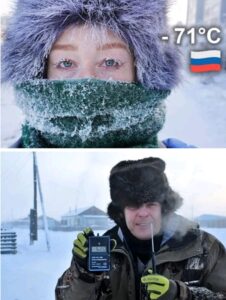
The length of day in Oymyakon in December is only 3 hours. There is only one local school that is open only when the temperature is above minus 52.
The craziest experience? A banana freezes rock-solid in just five minutes and can be used as a hammer. Here boiling water instantly transforms into clouds of ice, eyelashes and hair freeze within seconds, ink freezes in pens, batteries instantly run out, and spectacle glasses freeze to your face, and markets turn into natural freezers where nothing survives except meat. Doctor’s clinical thermometer would crack. Mobile phones do not work in such a cold, although there is a connection. Wet clothes freeze stiff like cardboard, and even simple things like soap bubbles turn into stunning ice crystals mid-air. Locals use heated garages for their cars. Cars left outside need to be kept running, otherwise they will not restart. Planes cannot fly into the area in the winter. And of course the risk of frostbite is great after only a few minutes in the cold. Farming is not possible on the frozen land, so folks mainly survive on a carnivorous diet.

And to add to agony in your daily life, most of the house toilets are built outside, (see picture above) because the severe cold makes it difficult for working indoor plumbing and flashing the waste. You might have to warm / heat the toilet commode before its use.
The bitter cold also makes it difficult to dig graves. The ground has to be warmed with a bonfire before a funeral, and it might take 2-3 days time. So, at the last, people say it’s better not to die here:
Bad enough!
So, what you read so far, is the news about Oymyakon, the “Pole of Cold”, the coldest human inhabited place on earth.
The Road of Bones
Once, under the gulag system, dozens of forced-labour camps were created at the mouth of the Indigirka River and further into the region. The making of Kolyma highway nicknamed “the road of bones”, started in the 1930s by political prisoners held in the gulags and links the port town of Magadan to the town of Nizhny Bestiakh. The construction, which lasted until Joseph Stalin’s death in 1953, claimed unaccounted number of lives. They are buried next to or directly under the 1,219-mile (1,961km) road, part of which is still not finished as it it considered an extremely difficult project despite modern equipment. Many prisoners and exiles, after their release, were unable to leave the area and remained in the localities.
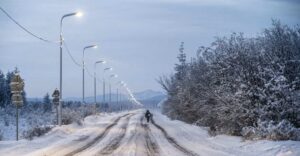
Those prisoners from the Dalstroy gulag were deployed as slave labour to build this road through the permafrost. It connects Yakutsk to the far eastern city of Magadan and passes through Khandaga. With just picks and shovels the inmates worked round the year building the 2000km long highway and in all horrendous conditions, many simply collapsed and died as they worked. The ground was deemed too hard to dig enough graves- the dead were simply covered with earth and stones. People now drive their cars over the victims all the way. That’s why Kolyma highway is nicknamed “The Road of Bones”.
At the secondary school, there is a local history museum dedicated to writers, poets, artists, cultural figures and scientists who served prison sentences in these regions or were sent into exile.
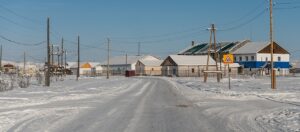
Oymyakon Settlement
Oymyakon settlement was named after the Oymyakon River, that is reportedly derived from the word kheium, meaning “unfrozen patch of water; place where fish spend the winter”. Another source says that the word heyum (kheium may be a misspelling), which means “frozen lake”, may be where it gets its name. The village is located near the historic Road of Bones. Over the last few decades, the population of Oymyakon has shrunk significantly. The village had a peak population of roughly 2,500 inhabitants, but that number has dwindled to fewer than 900 in 2018. The local economy is mostly trading of fur and ice fishing.
An airfield was built in the district of Aeroport during World War II, for the Alaska-Siberian (ALSIB) air route, used to ferry American Lend-Lease aircrafts to the Eastern Front.
Now, let’s find out where is the world’s coldest place?
And how do we firmly decide that is the coldest place?
Yes, not so easy to say from the record books. If any place is -100 degree today, tomorrow some place might be at -101 degree.
And to add more trouble, do we keep a constant record of temperatures of all the cold regions? The simple answer is no, its difficult. So, the scientists and environmentalists decided to take the average temperatures for a fixed time period, for example for at least one week or for one month period of few coldest regions and then studying the consistency in temperatures and then decide the coldest place in the hemisphere.
Oymyakon, the remote village in Russia’s Sakha Republic, (about 21-hour-long drive from Yakutsk) is considered the “coldest inhabited place” (inhabited human settlement) on Earth. Its extreme cold is a defining characteristic, with temperatures regularly plummeting well below freezing, even reaching record lows of -71.2 °C (-96.16 °F). This remote village of around 500 people is so cold that cars left outside need to be kept running, else the engine will stop and won’t restart. In the year 1924, Oymyakon recorded its lowest temperature, a frigid minus 71.2 C (minus 96.16 °F). It was such that wearing glasses outdoors could cause people to stick to the wearer’s face. This is just one of the problems of the extremely cold weather.
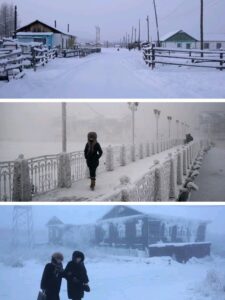
The plateau is within a large bowl-shaped depression called the Oymyakon depression, which has a dry, partly cloudy and frosty climate. In February 1933, a meteorological station in Tomtor recorded near‐surface air temperature of-67.7C, less than a couple of degrees warmer than the record low of -69.6C set in 1991 in Greenland. And due to the frozen ground, crops cannot grow here. The population survive mostly on meats. “Yakutians love the cold food, the frozen raw Arctic fish, white salmon, whitefish, frozen raw horse liver, but they are considered to be delicacy,” local Bolot Bochkarev told weather.com. “In daily life, we like eating the soup with meat. The meat is a must. It helps our health much.”
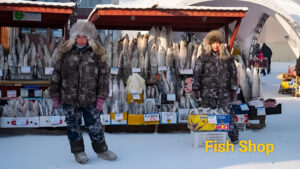
Temperature in Oymyakon goes down to an average of -58 degrees Celsius in the winters. There comes a time when the temperature reaches a point where the brain goes numb, people and eat heavy meat products to stay alive! But human brains work quite differently; they have come up with myriad tricks to survive the cold in their town. If you ever plan to visit this place, you’ll get reindeer meat and frozen fish as local delicacies. Another prominent cuisine of the place is ice cubes made using horse blood served with macaroni. All these are absolutely must have to survive in this cold place.
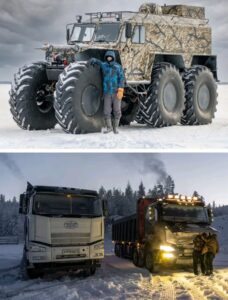
On the way to Oymyakon, trucks carrying coal or other heavy goods stop about 60 miles out after one of them breaks down because if the engines are left running for several hours, the wheels turn solid and the trucks will not be able to set off again until summer.
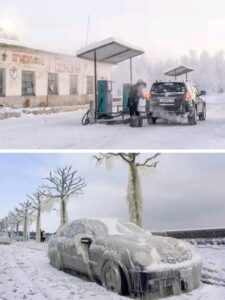
The nearest petrol station to Oymyakon is about 25 miles away, near Tomtor. Below -50C, the fuel consumption of an engine is estimated to double because of the severe strain that such low temperatures put on the combustion process as well as the oil and the battery. Any breakdown on the road, for unequipped travelers, can end in tragedy. At night, the vehicles are sheltered in heated garages and despite this, they take a long time to start.
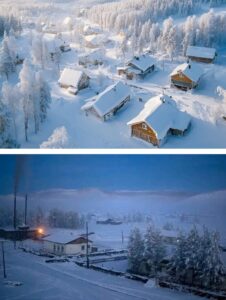
There is also a monument to the victims of Stalinist repressions called the Bell of Memory. Today, the Kolyma highway allows the transport of petrol and coal. Due to the cold, planes do not land in Oymyakon for several months of the year. The primary school in Oymyakon was founded in 1931. In 1951 it became the first secondary school in the region.

In early October, here, as in the whole of Sakha, also known as Yakutia, an anticyclone begins to form with increased atmospheric pressure. The polar night begins, during which there is a sharp cooling of the Earth’s surface, under which there is permafrost. Oymyakon is considered a climate regulator in Europe and is also closely monitored by meteorological stations.
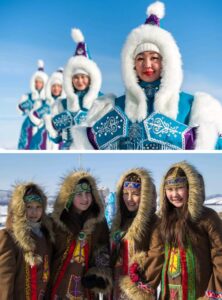
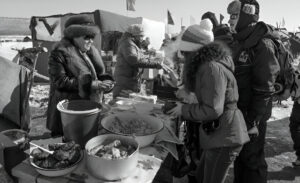
*******
Which are the other coldest places on the earth?
So far, a few records are:
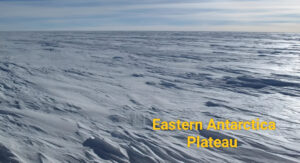
Eastern Antarctic Plateau, Antarctica (-94°C)
The Eastern Antarctic Plateau claims the title of coldest place on Earth. Satellite data collected between 2004 and 2016 across Dome Argus and Dome Fuji, an area around the size of Australia, suggests that air temperatures could be around -94°C. If these remote measurements are correct, this would be the coldest air temperature on Earth, and researchers think that the land temperature might be as low as -98°C.
Vostok Research Station, Antarctica — minus 128.6 F (minus 89.2 C)
Aug. 10, 2010, the Vostok Research Station, 808 miles (1,301 kilometers) from the geographic South Pole in Antarctica, was created by the Soviet Union in 1957. It held the world record for coldest temperatures. For a period of ten days in the southern hemisphere summer on July 21, 1983, weather data recorded a frigid minus 128.6 F (minus 89.2 C). the lowest air temperature ever directly recorded.
The journal of Geophysical Research, the researchers said that in situations, it could get even colder at the Vostok Station, with a potential record low temperature of minus 140.8 F (minus 96 C). It is also one of the driest places on Earth, receiving around 20 millimeter of precipitation a year, all of which is snow.
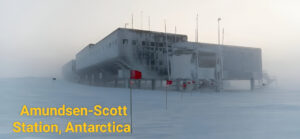
Amundsen-Scott Station, Antarctica (-82.8°C)
Located on the South Pole, the Amundsen-Scott Station was built in 1956 and gets six months of sunlight in the summer and six months of total darkness in the winter months. The highest temperature recorded on this part of the East Antarctic Plateau was on Christmas Day in 2011, where thermometers rose to a positively balmy -12.3°C. The coldest on record was -82.8°C in June 1982.
Denali, Alaska, United States of America (-73°C)
Klinck station, Greenland (-69.6°C)
The Klinck weather station holds the record for the coldest place in the Arctic Circle. Located in central Greenland, it beat the previous record held by Oymyakon by around 2 degrees in December 1991, reaching -69.6°C.
North Ice, Greenland (-66.1°C)
This research station, set up during the British North Greenland Expedition in the 1950s, held the record low temperature in North America at the time. In 1954, the temperature plunged to -66.1°C.
Yakutsk, Siberia, Russia (-64.4°C)
It is located in Siberia, one of the world’s coldest and most spaesely populated regions (an area that has few people in relation to its size. This is often due to physical factors like climate, elevation, or natural resources, as well as factors like economic opportunities and infrastructure). The population of Yakutsk is around 336,200, many of them work for Alrosa, a company that runs a diamond mine in the city. Temperatures in Yakutsk reached minus 76 F (minus 60 C). The average annual temperature of 18.5 F (minus 7.5 C), Average temperatures in Yakutsk are below 32 F (0 C) for six months of the year, with mercury levels reaching a maximum of around 68 F (20 C) in July. In 1891, temperatures dropped to -64.4°C.
Snag, Yukon Territory, Canada (-62.8°C)

In 1947, the small village of Snag in the Yukon of northwest Canada was home to around 10 First Nation people. The village was used as an emergency landing strip during second world war and later as a weather station, where temperatures was as low as -62.8°C, prompting researchers to get their equipment retested to make sure it was working correctly.
Prospect Creek, Alaska, United States of America (-62.1°C)
Built as a settlement for workers of the Trans-Alaska Pipeline System in the late 1970s, the village is now practically deserted. In January 1971, a frosty -62.1°C was recorded.
And here you thought winters in Alaska were harsh!
How is it even possible for people to survive in this icy land where winter seems to never end, where eyebrows and eyelashes freeze as does the saliva at the edge of your tongue? Photographer Amos Chapple spent a few weeks in the village and recorded the extreme lives and hardships of the villagers there. The pictures, while beautiful, also show exactly why you shouldn’t probably book your next vacation in Oymyakon.
******
Acknowledgements:
https://www.visitrussia.com
https://traveltriangle.com
https://travelrealrussia.com
https://www.dw.com
https://www.livescience.com
https://www.guinnessworldrecords.com
https://www.ndtv.com/travel/travel-influencer-explores
https://timesofindia.indiatimes.com/travel/destinations
https://www.theguardian.com/world
https://weather.com/travel/news
https://www.newscientist.com/question/coldest-places



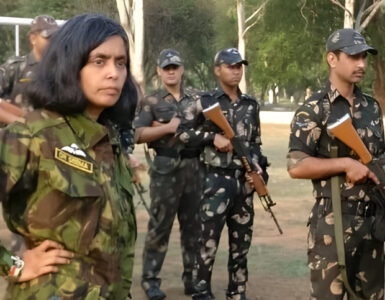











My God
I think only some “cold crazy” people would love to spend their life in such a place.
According to the author, the school will open if and only if temperature is above minus 52? Home toilets are outside the house because the toilet drainage would chock in the cold. Are you crazy!!
Eye opener article.
Too good.
Thanks so much.
Well written document.
I understand that you had gone through so many references, else such a elaborate, and to be precise document is not possible.
All the pictures are appropriate, and gives us that spot lifestyles.
Good article, thanks Mr. Deb.
True hardship.
Not only the daily habits, also the food that people survive mostly on meat, because farming is impossible. I can buy a car but that would be more embarrassing to maintain than my travel comforts.
Even if I wish to visit the place, my question would be how do I spend or survive there? Interesting place, but difficult to live also.
A real good article.
We must salute to those brave villagers who despite all the hardships on every aspects of life are living there, I assume they are quite happy there in the small world.
Credit to the author for choosing such an article and sharing the script and pictures that was not so clearly known to us.
An article worth reading.
Thanks.
I am a Russian, snow is my homeland in winter. I had been to Alaska and north Canada. I know this Oymyakon place very much, but somehow could not make it.
I know the place, and appreciate Asim’s effort to narrate it beautifully with pictures.
Thanks for sharing something very very special about our motherland.
Excellent article. Enhanced knowledge by reading. Thanks Asimda for such a nice one
পড়তে তো খুবই ইন্টারেস্টিং লাগলো, কিন্তু গিয়ে থাকা মুস্কিল।
আমি জানতাম সাইবেরিয়া, এতো আরও অনেক বেশি।
Oymyakon এর লোকদের বাহবা দিতেই হয়, দুনিয়ার যাবতীয় চ্যালেঞ্জ মোকাবিলা করেও বেঁচে থাকা যায়।
God is also unpredictable.
He builds Sahara, and he also builds Antarctica.
Minus 71 degrees !!!
Though I am a Russian, but still minus 71 is something unusual. I salute for the people living at both the places, Sahara and Oymyakon.
Thanks
একটা প্রশ্ন
ওখানে তো গ্রীষ্ম শরৎ হেমন্ত বা বসন্তের বলাই নেই। শুধুই শীত।
কিন্তু ওখানে কখন বর্ষা নামে? বা বৃষ্টি হয় কখন? আর বৃষ্টি হলে আবহাওয়া কিরকম হয়?
This is also the God’s wish to create a wonderland. Those who wish to stay, you are welcome to live in a land of peace.
A cold place. A Village where school opens only when temperature rises above minus 52 degree. Where my car requires constant revving , toilet requires heating before second use!
No, I dare not visiting there, not to think of residing.
Yet, people live there,build up s community ,however small.
That is the wonder of homo sapiens.
Quotes to Asim Deb for his efforts to introduce us to this aspect of human spirit
Qudos
After reading the article, I wish I should go once though I don’t know how much I shall be able to keep myself steady.
Let me plan for a day trip, reaching at 10 morning and leave by afternoon.
Courtesy social media and tourism industry, we know about Alaska, Antarctica, Siberian cold. But the article took me to an interesting and unknown world which gets its mention in different record books.
Even after reading this one, I could not even believe the Road of Bones, a highway that was made on the dead bodies of countless helpless construction workers.
I would request the author if you can write something more on their daily life.
Thanks
Read it, and interesting.
But author has given only some briefing of the place, would request if you could write in depth, a little details please.
Thanks
তোমার লেখা পড়ে জানতে পারলাম বিশ্বের শীতলতম স্থান-The coldest human inhabited place on earth.
খুব ভাল লাগল। অজানাকে জানার আগ্রহ মনকে নতুন নতুন সন্ধান এনে দ্যায়। এই ধরণের রচনা মনে এক বিশেষ তৃপ্তি এনে দ্যায়।
তবে আমার অনুসন্ধিৎসা থেকে কিছু প্রশ্ন আসে। অত ঠান্ডার মধ্যে ওখানে কোন পশু থাকতে পারে যার শক্ত মাংস খেয়ে মানুষেরা বাঁচে। স্থানীয় বাসিন্দাদের জীবিকা নির্বাহে গ্রাম ছেড়ে অনেকটা দূর যেতে হয়। তাদের দৈনন্দিন যানবাহন সমস্যা কিভাবে মেটায় ? এগুলোর ব্যাখ্যা যদি জানাও তো অনুসন্ধিৎসা দূর হয়।
এক নিমেষে পুরো রচনাটা পড়ে ফেললাম। আরও নতুন কিছু জানার ইচ্ছে রইল। সাধুবাদ জানাই। ♥️
Amazing! This is exemplary, where people have opted for ultimate hardship and so gracefully converted the hardship into a way of living. Salute to the 500 inhabitants of this village and thanks Dada for sharing such a interesting article. Keep enlightening us with your fascinating pieces of article on the unknown facets of this planet.
Interesting artcle. Had glimpses of human life style & struggle to survive in earth’s coldest region of human inhabitation. Life is full of struggle. Struggle for food, day to day life, keeping their vehicle on running condition. In past I read some articles regarding why mighty Nepolean & Hitler was unable to conquire Russia due to severe cold weather in this region. German soldiers could not withstand the extreme subzero temperature. Butter used to become rock hard. Even they could not pass the stools which led to deteriation of their health. Frost biting was unbearable. In such a situation trained Russian sodiers from Siberia surrounded them & attacked them . German soldiers had to accept the defeat.
Thanks for your nice comments, you gave us some more information about the Russian cold.
By the way, I don’t find you name, its showing Anonymous. Kindly share your name.
Interesting artcle. Had glimpses of human life style & struggle to survive in earth’s coldest region of human inhabitation. Life is full of struggle. Struggle for food, day to day life, keeping their vehicle on running condition. In past I read some articles regarding why mighty Nepolean & Hitler was unable to conquire Russia due to severe cold weather in this region. German soldiers could not withstand the extreme subzero temperature. Butter used to become rock hard. Even they could not pass the stools which led to deteriation of their health. Frost biting was unbearable. In such a situation trained Russian sodiers from Siberia surrounded them & attacked them . German soldiers had to accept the defeat.
A different and difficult place to live, specially if you don’t have any idea about living on ice. This particular place is beyond the coldness of Antarctica or Alaska in general.
The pictures are well attached. Gives better visual clarity of the place.
এই লেখাটা পড়ে সত্যি এক নতুন অভিজ্ঞতা হলো। এইরকম কোনো জায়গায় যে মানুষ জন থাকতে পারে তার সমন্ধে কোনো ধারণা ছিলো না। জানিনা লেখক নিজে বহুদিন রাশিয়া তে ছিলো বলে কিনা এইরকম একটা জায়গার খোঁজ পেয়েছেন এবং সেই ব্যাপারে আমাদের অবগত করেছে। ভাবাই যায় না কি করে মানুষজন এতো temp এ বসবাস করছে। এর হয়তো একটা প্রাকৃতিক সৌন্দর্য আছে কিন্তু এইরকম পরিবেশে মানুষের পক্ষে থাকা একটা ভয়ঙ্কর অভিজ্ঞতা। সবচেয়ে বড় কথা মানুষের দীর্ঘ দিন ধরে বসবাসের জন্য এবং দৈনন্দিন কাজের জন্য এবং বেঁচে থাকার জন্য বেশ কিছু নিত্য প্রয়োজনীয় জিনিসের দরকার পরে সেগুলো তারা কিভাবে জোগাড় করে? ভাবতে অবাক লাগছে এই পরিবেশেও কিছু সংখ্যক লোক এখনো ওখানে বসবাস করছে। এইরকম তথ্য সহকারে এইরকম জায়গার সমন্ধে লেখা খুব একটা দেখা যায় না। লেখক কে আবার ধন্যবাদ শেষ করছি।
পুনঃ : ওখানে যাবার সুযোগ পেলেও যাওয়ার ইচ্ছে এই বয়সে হবে না। 👏🏽👏🏽🙏🏽❤
Interesting article.
Winter has its own beauty, it’s own charm and attraction, but not the same for everyone. And specially when it comes to minus, lands are under the ice.
I would love to go to visit such places though I know that it’s not possible, most likely.
Though Russian, I would dare to go to this place. I am from a place near the city of Kazan, down south of Oymyakon, and I face minus 35 in winter. I can dream of minus 50 (even in summer), but would not like to experience such cold.
The write up is nicely written with pictures, and gives a vivid description of Oymyakon zone and with details of human life.
Asim,
I can’t believe!
Life is normal and schools are open till minus 52 degrees? This -52° is summer or spring?
I am now too curious. I have to study about the people of this land. You have given me a good article, resulting a good task.
Thanks
My salutes for the people of Oymyakon. If they can live happily in such a constrained condition, they deserve credits. It is possibly beyond imagination for most of the people of other regions that how can people are survive here.
I was not aware of such place, credit must go to the author who did too much of search works and compiled it. The photographs are excellent and added more clarity of the place,
Thanks author.
Lands under deep ice specially in winter is understandable, but if that’s minus 30/40 even in summer is too much to bear. But, wonderfully the God is also kind enough to protect his people, giving them the strength to survive.
Interesting in the sense that the article could create some curiosity to know more about the place.
Nicely composed with good photography.